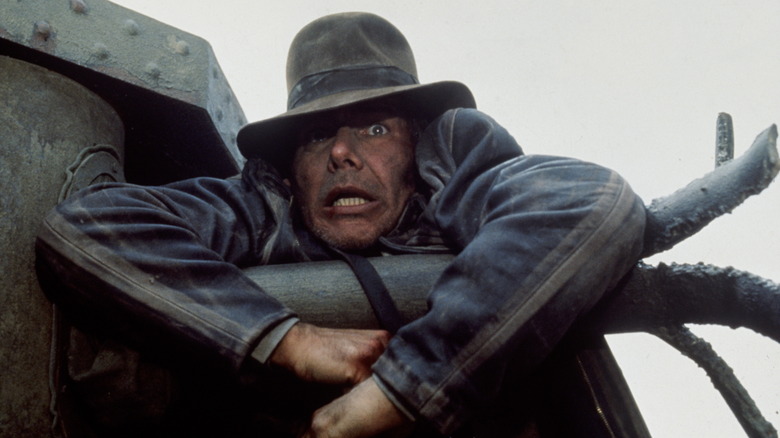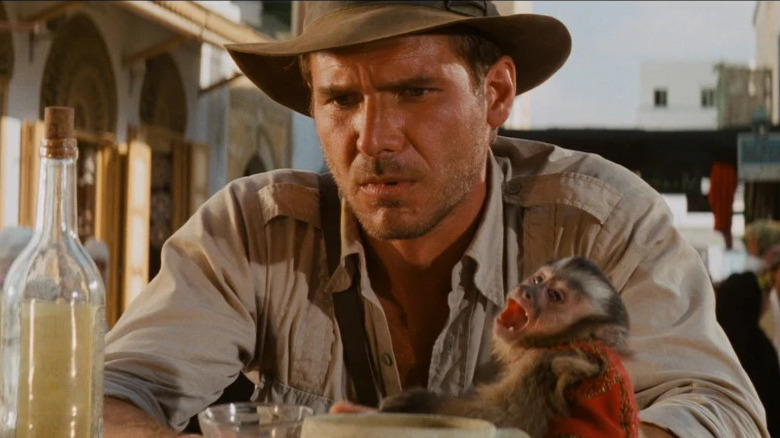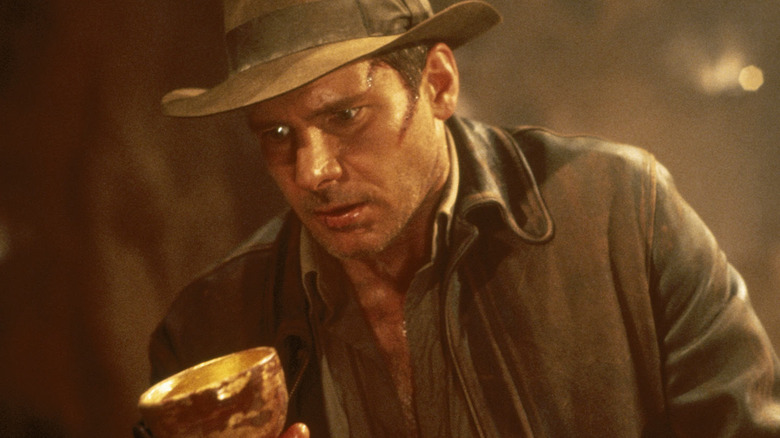Monty Python Made Steven Spielberg Unsure Of Indiana Jones And The Last Crusade
The Holy Grail is one of the most important items in the whole of Arthurian legend — it brings eternal life to anyone who drinks from it. Because of this, the item is highly sought after. Unfortunately for those who seek its power, it also is famously difficult to find, with the Grail itself becoming symbolic of near-impossible goals.
For a filmmaker, the proverbial Holy Grail of their profession could be considered making a film that is a timeless classic, the sort of film that can be watched 40 years later and still hold up. The sort of film that a dad forces his kids to watch and they actually don't hate it.
In 1975, the British comedy group Monty Python found their Holy Grail with their second feature film, "Monty Python and the Holy Grail," which became a huge hit in both Britain and the United States. A satirical take on the stories of Arthurian legend, the legendary sketch group made their biggest mark on history with this film, creating multiple sequences that are still constantly referenced to this day, whether it be the Holy Hand Grenade, the knights that say "Ni," or the newly limbless Black Knight proclaiming "It's just a flesh wound!"
With one film about the Holy Grail already massively successful, one can understand why, when presented by producer George Lucas with the idea of Indiana Jones pursuing the Holy Grail on his next adventure, director Steven Spielberg was hesitant.
The monkey king?
The first two Indiana Jones films were extremely successful, and Steven Spielberg felt the pressure for the third film to live up to the previous two. This meant going through a lot of ideas before even considering a Holy Grail story.
The film was originally entirely different, and wild. The original working title was "Indiana Jones and the Monkey King." The idea, which had a treatment written by George Lucas that was then buffed up by "Gremlins" writer Chris Columbus, featured Indy fighting an army of gorillas, getting killed and brought back to life, and being pursued by nazis with machine gun arms. This certainly would have been the most unhinged entry into the franchise, to say the least. Luckily, Spielberg shut the idea down for being "too fanciful."
It was at this point that George Lucas brought the idea of a search for the Holy Grail back to Spielberg. Once again (and understandably, after the monkey king idea), Spielberg was hesitant to take Lucas' idea. According to a 2012 Empire piece, Monty Python was immediately on Spielberg's mind. "I immediately said, 'Does that mean that jugular-biting white rabbits are going to come flying out of caves?' As far as I'm concerned, the Holy Grail remains defined by the Pythons," said Spielberg.
It made sense. Why make a film about the same topic that had been legendarily spoofed by a previous, ultra-successful film?
Finding the Grail
It was up to George Lucas to talk Spielberg into the idea. After assuring him that their Holy Grail film "is going to be serious," they began production on the film that we all have come to know and love.
The film ended up being a touch lighter than its predecessor, "Indiana Jones and the Temple of Doom," which was plagued a bit by a lack of fun and more racial insensitivity than you'd ideally want in any film. "With 'Last Crusade', we decided to go back to our roots. We came back to the Holy Grail — I call it the 'Chalice From The Palace' — which we had rejected a couple of times as being too ethereal," said Lucas, casually throwing out another bad idea that lends some clarity to how the "Star Wars" prequels ended up how they did. "It had to have some power, so we invented qualities to make it important."
With the new and simpler plot, along with the genius choice to bring Sean Connery in as Indiana Jones' estranged father, "Indiana Jones and the Last Crusade" came into being and it's my personal favorite entry into the series. The dynamic between Connery and Harrison Ford is extremely fun and gives the film a bit of a "buddy-cop" vibe, all while also deepening the character of Indiana Jones by exploring some of his emotional motivations.
"The Last Crusade" ended up being another Holy Grail film from Spielberg, who has spent his whole career finding Grail after Grail. So now there are two extremely famous and successful Holy Grail movies, and that's probably quite enough for now.


